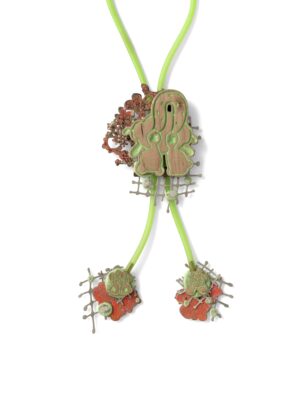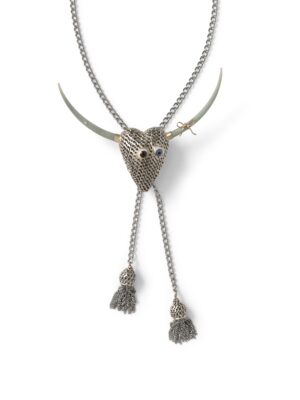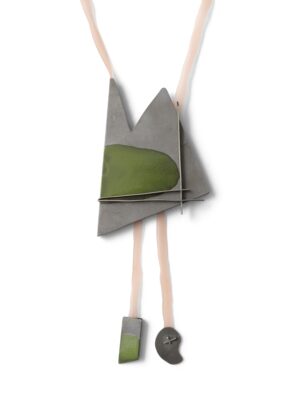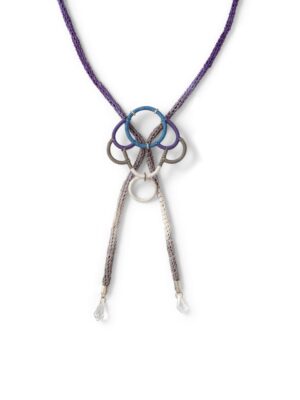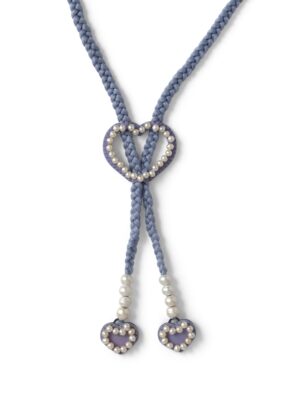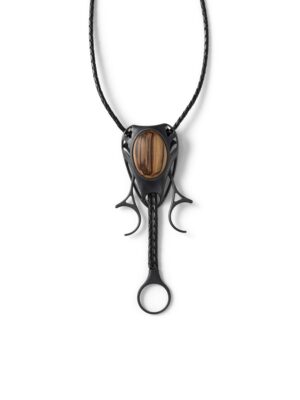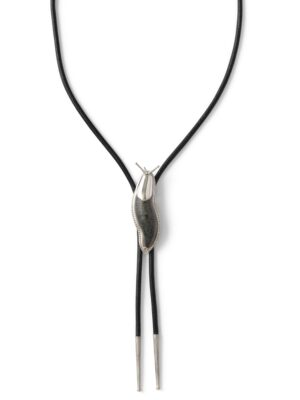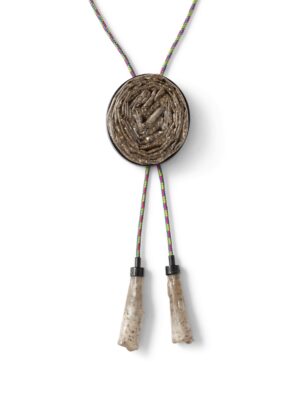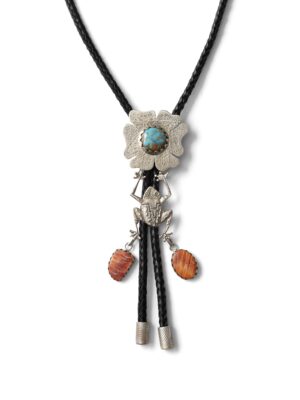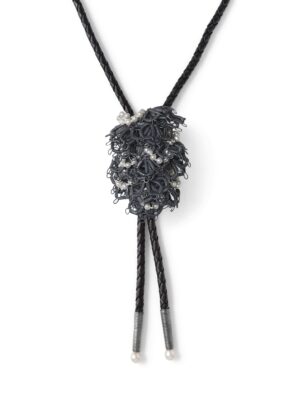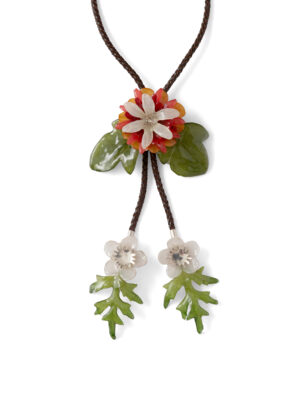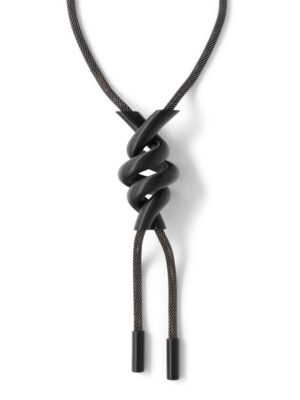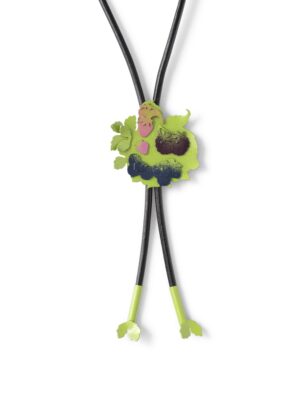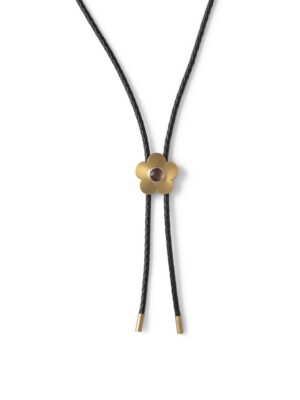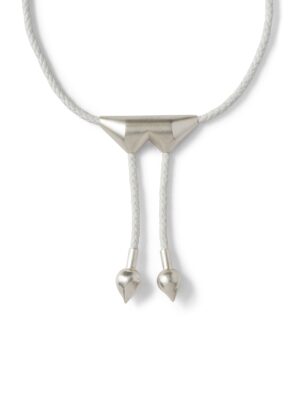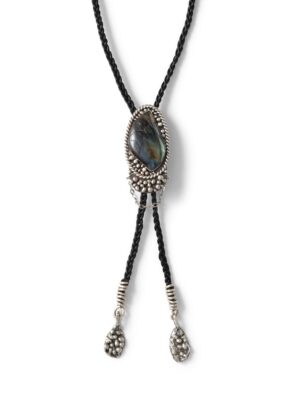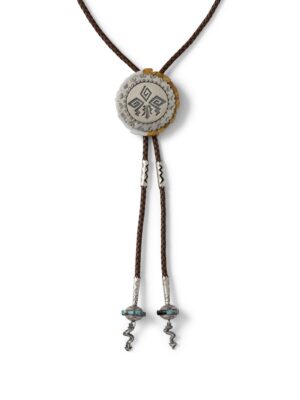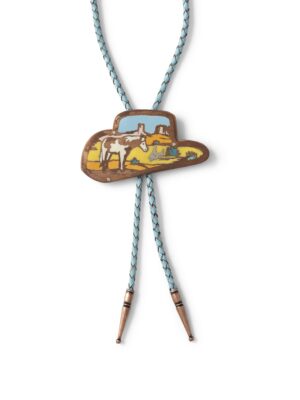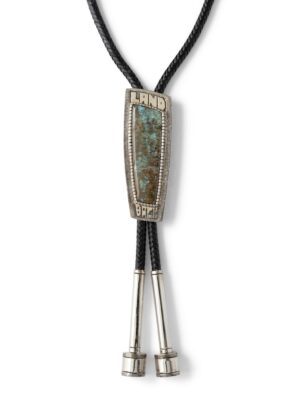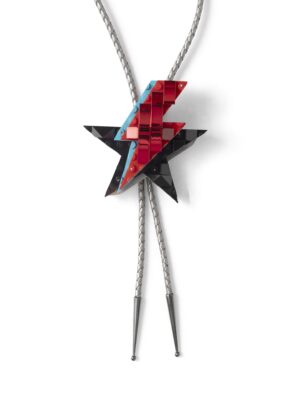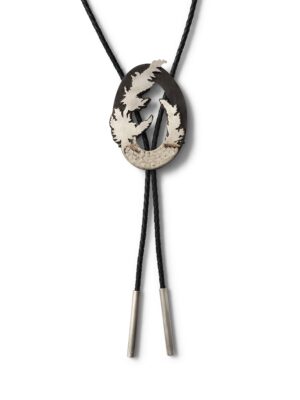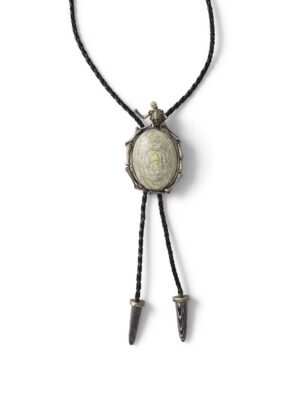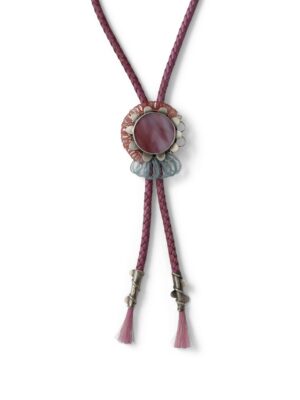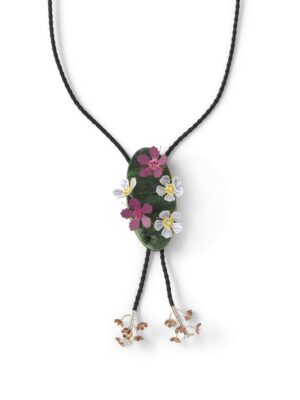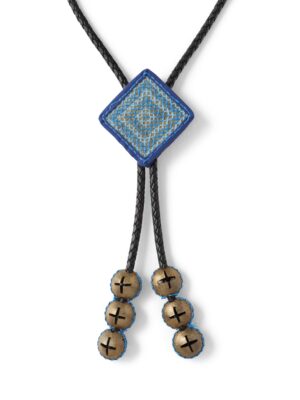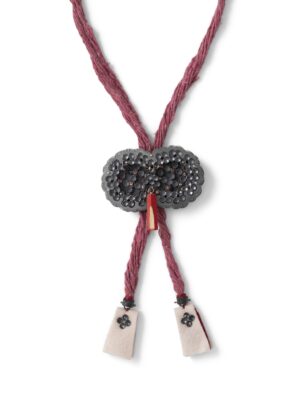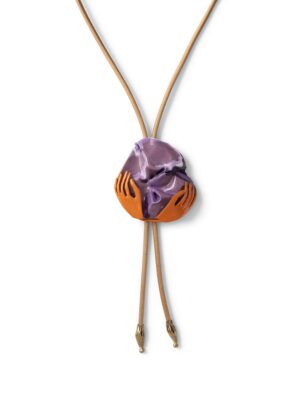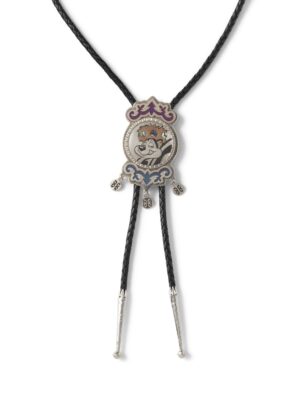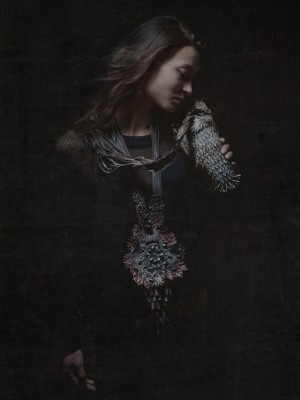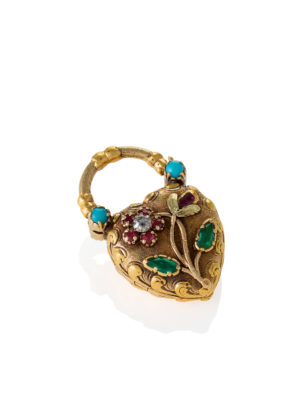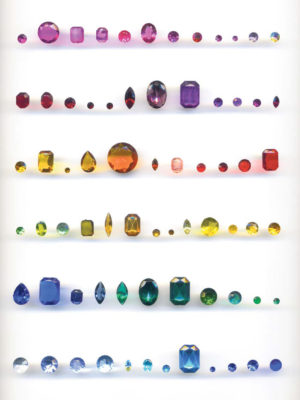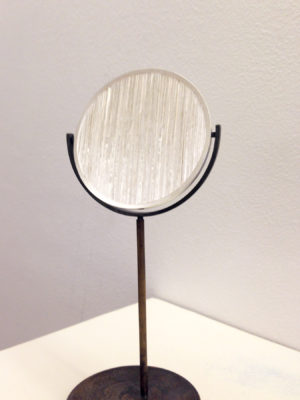Igniting the spark for this intriguing research was Hannah Toussaint, a metalsmith and craft artist, a UNT alum, and a current M.F.A. candidate at the University of Georgia, Athens, Ga, who approached her professor, Ana M. Lopez, with an idea to explore the bolo tie as a symbol of adornment within the queer community. This concept soon expanded with the invaluable experience and insights of Brian Fleetwood, an assistant professor of studio art at the Institute of American Indian Arts in Santa Fe, N.M., and a citizen of the Muscogee Nation of Oklahoma, alongside contributions from 27 additional artists. Together, they unveiled their remarkable findings. Entitled “Everybody’s Bolos,” the exhibition showcases the creations of 30 contemporary artists who were invited to apply their distinct perspectives to the bolo tie, reimagining this traditional accessory in fresh, innovative ways. The event was a collaborative effort, co-organised and co-curated by Ana M. Lopez, professor of Studio Art: Metalsmithing and Jewellery at the University of North Texas; Brian Fleetwood; and Hannah Toussaint.
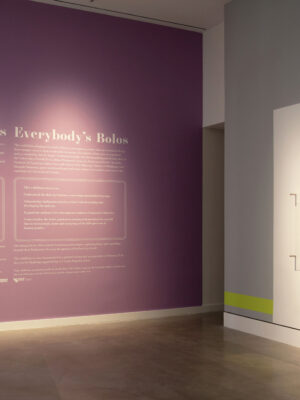
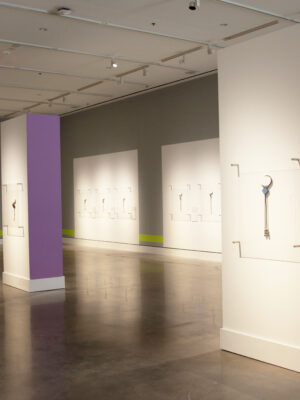
Everybody’s Bolos is a chance to consider the next evolution of the bolo tie. If the works in this exhibition are any indication, what makes a bolo tie a bolo tie is the act of bringing together. This personal ornament offers the opportunity to express one’s individuality and is available to all; they are everybody’s bolos.
– Lopez
History of Bolo Ties
The bolo tie is a relatively new and ambivalent format. It exists between a necklace and a necktie. “It is made by jewellers but not discussed as jewellery. It has existed for approximately one hundred years, which is negligible in the history of personal adornment. It is affiliated with Indigenous peoples but is not an element of their traditional dress. The liminality of the bolo tie is part of what makes it such an interesting topic to explore,” says Lopez.
Largely seen as an essential accessory for many people in Indigenous and Hispanic communities, bolo ties have also been adopted by hipsters and “appropriated by wealthy elites and politicians as a somehow simultaneously overly self-conscious performance of hypermasculinity and a cynical attempt to affect a folksy working-class persona,” according to Fleetwood. Nowadays, the authenticity of the form is trendsetting, being appropriated by fashion designers, and being driven away from its historical significance, stuck between historical eras and authentic rights to its form.
Jillian Moore
Mons Bola
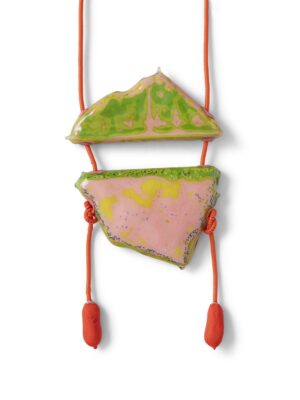
”How, then, could I make a piece that honored the feeling that first bolo tie inspired with my awareness of its much more complex cultural position? I’ve attempted to make a wearable object about the confection of the wild west, with a relationship to the visual language of the bolo tie that places the piece in an ambiguous location. It is my own exploration of that fantasy of hypermasculinity couched in cowboy drag, with my big rock candy mountains, cotton candy colors, and dangley gonad baubles. It has about the same proximity to tradition as a souvenir made of pot metal and hot glue.”
The bolo tie’s association with the American West, and the myth of its ‘taming,’ is belied by a history and aesthetic that is fundamentally connected to the silversmithing traditions of the Native peoples of the American Southwest and a history of cowboys that is browner, blacker, queerer, and more Indigenous than the myth depicts.
– Fleetwood
Gender/Less
To understand the bolo tie is to acknowledge its history and the role of Indigenous artists that paved the way for the present-day context of genderless and ornamental bolo ties, encapsulating the “full spectrum of human gender.”
The aesthetic of the American West, the cowboy, and the performance of the hyper-masculine by elite white men contradicts the same-sex fluidity represented by queerness in the West. Queer stories went untold, and history focused on the heteronormative narratives of the predominant male lens that “cemented” the image of the white cowboy into the public sphere, although according to Fleetwood, “the act of performing rural drag is distinct from the subversive queer gender performance of drag kings and queens in that it upholds and exploits the ‘traditional’ gender norms of American heteropatriarchy.”
Despite this visual erasure of history, Toussaint claims that there are Hispanic, Indigenous, and LGBTQ+ “cowfolks” who have adopted the bolo and other Western-style ornaments, fashion elements, and uniform pieces.
Toussaint writes, “The representation of only one type of figure moving through that space and time feels like an intentional erasure of everyone who existed within—with various gender identities and presentations, and moulded the history of places we now view as triumphantly occupied by the white and straight… I am proposing the bolo as a future for genderless adornment, looking to our queer Western ancestors who found, through solitary lives often in quiet, lonely places, a way to move through the world with some kind of acceptance.”
But really, bolos are for everybody.
Bee Reid
Violet Body
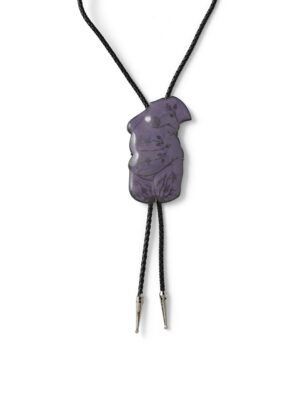
”My Bodyseries seeks to highlight and celebrate underrepresented bodies. To further connect to the queer aspects of bolos, the form is adorned in violets. Violets have been associated with queer love, especially sapphic desire, since Ancient Greece. The poet Sappho wrote of adorning her lover in violets. The format of bolo ties allows for the fat, queer form to be prominently shown on the wearer’s chest, proudly displayed.”
”Everybody’s Bolos”
Feb. 6–May 10, 2024
CVAD Gallery, UNT Art Building, Room 160
Free | Open to the Public
More information about the exhibition here.
Participating Artists
Sulo Bee, Lola Brooks, Kat Cole, L M deLeon, J Taran Diamond, Bee Reid, Sean Eren, Teresa Faris (Sámi Descendant), Carly Feddersen (Colville Confederated Tribes – Okanogan + Arrow Lakes), Brian Fleetwood (Mvskoke), Motoko Furuhashi, Jonah Hill (Que Chan /Hopi), Sarah Holden, Chris Irick, Margaret Jacobs (Akwesasne Mohawk), Mia Kaplan, Ana M. Lopez, Vanessa B. Miller, Jillian Moore, Jerome Nakagawa (Diné and Japanese), Wyatt Nestor-Pasicznyk, JJ Otero (Navajo/Hopi), emiko oye, Audrey Peck, Hannah Reynoso Toussaint, James Thurman, Aric Verrastro, Grey Von Cannon, Jodi Webster (Ho-Chunk Nation and Prairie Band Potawatomi Nation), Ger Xiong/Ntxawg Xyooj (Hmong American).
